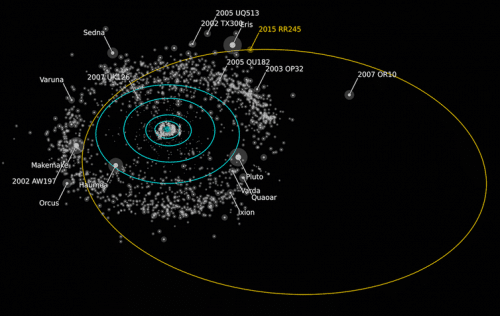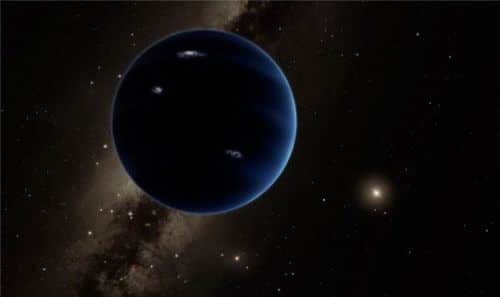These objects are divided into two populations - those that orbit the Sun in a circular orbit within the Kuiper Belt and those with elongated orbits that come even closer than Neptune-Rahab to the Sun and are many tens of astronomical units away. They belong to the family of Pluto and they are many that have been believed so far

Author: Michelle Bannister, Research Fellow in the Department of Planetary Astronomy, Queen's University Belfast. Translation: Avi Blizovsky
Our solar system is a tiny but incredibly familiar corner of the vast, dark universe - we've even managed to land spacecraft on our celestial neighbors. However, its outer area has not yet been mapped. In a recently published survey, 840 small worlds are revealed in the remote and hard-to-discover region beyond Neptune. This is the largest discovery of bodies at the edge of the solar system that has ever been discovered and it increases the number of distant objects whose orbits around the sun are known by 50%.
The small ice worlds are important because they help us tell the history of the solar system. They could also help us test the idea that a large, unseen planet lurks in the outer solar system.
Our solar system as we see it today does not resemble the solar system at the time of its formation. When the Sun was young it was surrounded by a large disk of material. Collisions with tiny and large planets, including some of the newly discovered worlds, caused the gas giants to move away from the Sun until they settled in their current locations. The rest of the bodies that then began to form were scattered everywhere, into the inner solar system and out into the outer solar system.
Planetary migration has also occurred in many distant solar systems. Fortunately, the objects in the solar system are relatively close, making it the only place where we can see the intricate details of how the migration occurred. Mapping the populations of the small objects left from the disk allows us to reconstruct the history of pushing the large planets into their current orbits.
Mapping the sky
The new discoveries are the result of a five-year project called the Outer Solar System Survey (OSSOS). In the observations, conducted in the years 2017-2013, the researchers used the imaging camera of one of the largest telescopes in the world - the Canada-France-Hawaii telescope on the summit of Mount Maunkia in Hawaii. They searched for faint, slow points of light in eight large areas of sky near the plane of the planets, away from the crowded star fields of the Milky Way.
The 840 discoveries span from six to 83 astronomical units (au), one such unit being the distance between the Sun and Earth. The survey therefore gives us a very good overview of many types of orbits of these trans-Neptunian objects.
Previous surveys suffered from missing some of the distant objects, when too few observations were made. The expected path of a minor planet in the sky will be so uncertain that it will be impossible to recognize it again in a telescope and it is that telescope is considered "lost". This happens more to objects with very long orbits, causing a bias in our knowledge of these object populations.
Our new survey successfully tracks all distant objects. The frequent photographs of the 840 objects over several years meant that each orbit of such a small world could be precisely determined. In total, more than 37,000 manual measurements were made of hundreds of objects whose trajectory was precisely determined.
We have also created simulator software (a computer model), which provides a powerful tool for examining the composition and history of our solar system. The simulator allows theorists to test their models of how the solar system came to be as we see it today and compare them to our actual discoveries

Strange new worlds
The new cold objects are divided into two main groups. One includes the bodies orbiting the Sun in circular orbits in the Kuiper Belt, which extends from 50-37 AU from the Sun. The second group consists of worlds that are in a careful dance path with Neptune in its orbit around the Sun but avoid getting really close to it. These are "resonating" trans-Neptunian objects and Pluto is among them. These dwarf planets were pushed into their current elongated orbits during Neptune's outward migration.
In the Kuiper belt we found 436 small worlds. Their orbits confirm that the "core" of these ice blocks is concentrated in round, flat orbits at a distance of 45-43 astronomical units. These quiet orbits have not been disturbed since the dawn of the solar system. These are remnants of the original disc. We will soon see a member of this group up close: the "New Horizon" spacecraft, which visited Pluto in 2015, will pass by a world the size of a large city on January 1, 2019.
We also discovered 313 resonant trans-Neptunian objects, far more than we had estimated so far. Among these discoveries is the dwarf planet 2015 RR245, which is hundreds of kilometers in diameter, and which is estimated to have reached its current orbit at a distance of 82 astronomical units after an encounter with Neptune hundreds of millions of years ago.
Are there other planets?
Among the most unusual discoveries are nine small worlds with incredibly distant orbits. They never come closer to the Sun than Neptune's orbit, and it takes them up to 20,000 years to orbit the Sun. Their existence suggests an unseen population of hundreds of thousands of trans-Neptunian objects with similar orbits.
How these objects got to their current orbits is not clear. In the outer part of their orbit they barely even feel Neptune's gravity. One explanation that has been suggested is that an unseen planet, sometimes referred to as the "ninth planet," could cause them to cluster in space. However, our nine dwarf planets are spread uniformly, rather than in clusters, which rules out the existence of a "shepherd" planet, or that these orbits were formed for some other reason.
The history of our solar system is just beginning to unfold. We hope this collection of discoveries will help uncover more details in the story.
For the article in THE CONVERSATION
More of the topic in Hayadan:
- Is the strange inclination of the sun caused by the influence of the ninth planet?
- Why does a group of researchers want to reopen the debate on the definition of planets?
- Indirect evidence for the existence of a ninth planet: a gas giant that orbits the Sun once every ten thousand years
- Surprising discovery: New Horizons photographed young mountains on Pluto and Charon

4 תגובות
If we think about the capellar orbit of AZ-71, it can be understood that their orbit is linear and they are not bound to the original orbit of the ninth star, these are only as a unifying group of one or other capellar orbits
I did not understand the last sentence, regarding the negation of the ninth star
Experience
6 AU? That is, more internal than Saturn? Does it mean that the calculation shows that those with an especially eccentric orbit will arrive in thousands of years closer to the sun than Saturn (and will influence and be influenced by Saturn, Jupiter, Uranus and Neptune)?